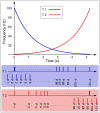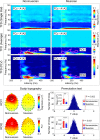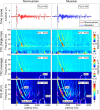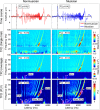Electrophysiological evidences demonstrating differences in brain functions between nonmusicians and musicians
- PMID: 26338509
- PMCID: PMC4559803
- DOI: 10.1038/srep13796
Electrophysiological evidences demonstrating differences in brain functions between nonmusicians and musicians
Abstract
Long-term music training can improve sensorimotor skills, as playing a musical instrument requires the functional integration of information related to multimodal sensory perception and motor execution. This functional integration often leads to functional reorganization of cerebral cortices, including auditory, visual, and motor areas. Moreover, music appreciation can modulate emotions (e.g., stress relief), and long-term music training can enhance a musician's self-control and self-evaluation ability. Therefore, the neural processing of music can also be related to certain higher brain cognitive functions. However, evidence demonstrating that long-term music training modulates higher brain functions is surprisingly rare. Here, we aimed to comprehensively explore the neural changes induced by long-term music training by assessing the differences of transient and quasi-steady-state auditory-evoked potentials between nonmusicians and musicians. We observed that compared to nonmusicians, musicians have (1) larger high-frequency steady-state responses, which reflect the auditory information processing within the sensory system, and (2) smaller low-frequency vertex potentials, which reflect higher cognitive information processing within the novelty/saliency detection system. Therefore, we speculate that long-term music training facilitates "bottom-up" auditory information processing in the sensory system and enhances "top-down" cognitive inhibition of the novelty/saliency detection system.
Figures







Similar articles
-
Preattentive cortical-evoked responses to pure tones, harmonic tones, and speech: influence of music training.Ear Hear. 2009 Aug;30(4):432-46. doi: 10.1097/AUD.0b013e3181a61bf2. Ear Hear. 2009. PMID: 19494778
-
Modulation of Functional Connectivity in Auditory-Motor Networks in Musicians Compared with Nonmusicians.Cereb Cortex. 2017 May 1;27(5):2768-2778. doi: 10.1093/cercor/bhw120. Cereb Cortex. 2017. PMID: 27166170
-
The Mismatch Negativity: An Indicator of Perception of Regularities in Music.Behav Neurol. 2015;2015:469508. doi: 10.1155/2015/469508. Epub 2015 Oct 4. Behav Neurol. 2015. PMID: 26504352 Free PMC article. Review.
-
Enhancement of auditory-evoked potentials in musicians reflects an influence of expertise but not selective attention.J Cogn Neurosci. 2008 Dec;20(12):2238-49. doi: 10.1162/jocn.2008.20157. J Cogn Neurosci. 2008. PMID: 18457513
-
Effects of musical training on the auditory cortex in children.Ann N Y Acad Sci. 2003 Nov;999:506-13. doi: 10.1196/annals.1284.061. Ann N Y Acad Sci. 2003. PMID: 14681174 Review.
Cited by
-
Early auditory processing in musicians and dancers during a contemporary dance piece.Sci Rep. 2016 Sep 9;6:33056. doi: 10.1038/srep33056. Sci Rep. 2016. PMID: 27611929 Free PMC article. Clinical Trial.
-
What a difference a syllable makes-Rhythmic reading of poetry.Front Psychol. 2023 Feb 13;14:1043651. doi: 10.3389/fpsyg.2023.1043651. eCollection 2023. Front Psychol. 2023. PMID: 36865353 Free PMC article.
-
Effects of Long-Term Musical Training on Cortical Auditory Evoked Potentials.Ear Hear. 2017 Mar/Apr;38(2):e74-e84. doi: 10.1097/AUD.0000000000000375. Ear Hear. 2017. PMID: 28225736 Free PMC article.
References
-
- Strait D. L., Kraus N., Parbery-Clark A. & Ashley R. Musical experience shapes top-down auditory mechanisms: Evidence from masking and auditory attention performance. Hearing Res 261, 22–29 (2010). - PubMed
-
- Ohnishi T. et al. Functional anatomy of musical perception in musicians. Cereb Cortex 11, 754–760 (2001). - PubMed
Publication types
MeSH terms
LinkOut - more resources
Full Text Sources
Other Literature Sources

